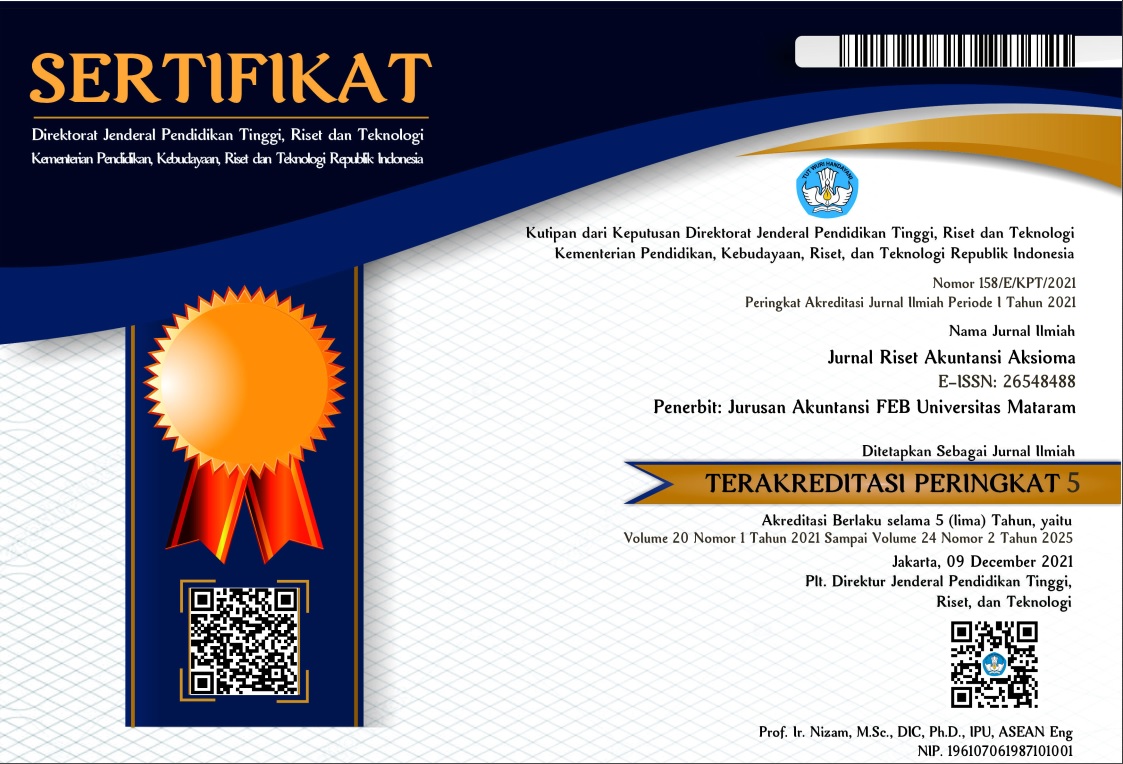DETEKSI KECURANGAN LAPORAN KEUANGAN DI MASA PANDEMI COVID-19 DENGAN MODEL BENEISH M-SCORE DAN MODEL F-SCORE
Abstract
The purpose of this study is to detect fraudulent financial statements committed by companies. This detection is carried out by 2 (two) methods, namely the Beneish M-Score method and the F-Score model. The Beneish M-Score model is a predictive model of financial statement fraud, the ratios contained in it have been proven to have the ability to predict financial statement fraud (Beneish, 1999). The F-Score is a measure used as a tool to detect material misstatements in financial statements (Pardosi, 2015). Data analysis of go-public companies in Indonesia listed in 2019 and 2020 was obtained from Osiris. The results of the study concluded that the average value of financial statement fraud decreased during the covid-19 pandemic, with an average decline of 74%. Paired t-test results are also shown in the sig value. (2-tailed) that the F-Score and M-Score calculations show a number greater than 0.05 which means that there is no significant difference in the F-Score and M-Score values before and during the COVID-19 pandemic. It was concluded that the COVID-19 pandemic did not affect financial statement fraud in Indonesia.
References
Association of Certified Fraud Examiners. (2019). Report to the nation on occupational fraud and abuse (2018 global fraud stud). Available at https://s3-us-west- 2.amazonaws.com/acfepublic/2018-report-to-the-nations.pdf
Association of Certified Fraud Examiners. (2020). Report to the nation on occupational fraud and abuse (2020 global stud). Available at https://acfepublic.s3-us-west- 2.amazonaws.com/2020-Report-to-the-Nations.pdf
Beneish, M.D. (1999) “The detection of earnings manipulation”. Financial Analysts Journal 24 – 36.
Brennan, Niamh M dan Mary McGrath. 2007. ”Financial Statement Fraud: Some Lessons from US and European case Studies.” Australian Accounting Review, Vol.17, No.2.
Dechow, P. M., Ge, W., Larson, C. R. & Sloan, R. G. (2011). Predicting Material Accounting Misstatements. Contemporary Accounting Research, 28: 17–82.
Dechow, P. M., Weili, G., Chad, R. L., & Richard, G. S. (2007). Predicting material accounting manipulations. Paper, AAA 2008 Financial Accounting and Reporting Section (FARS)
Deny, S. (2013). BUMN Masih Sering Curang. https://www.liputan6.com (diakses tanggal 11 Januari 2021).
Hakim, I. L. (2015). Skandal Terungkap, CEO Toshiba Mundur. https://www.liputan6.com (diakses tanggal 11 Januari 2021).
https://www.acfe.com/fraud-tree.aspx
Hugo, J. (2019). Efektivitas Model Beneish M-Score Dan Model F-Score Dalam Mendeteksi Kecurangan Laporan Keuangan. Jurnal Muara Ilmu Ekonomi dan Bisnis, 3(1), 165-175.
Ikatan Akuntan Indonesia. 2015. Standar Akuntansi Keuangan. Jakarta: Ikatan Akuntan Indonesia.
Mahama, M. (2015). Detecting Corporate Fraud and Financial Distress Using the Altman and Beneish Models: the Case of Enron Corp. International Journal of Economics, Commerce and Management, 3(1):1-18
Ningtyas, E. S. (2015). Kasus Fraud Audit pada Bank BRI. https://www.kompasiana.com (diakses tanggal 11 Januari 2021).
Pardosi, R. W. (2015). Analisis Fraud Diamond Dalam Mendeteksi Kecurangan Laporan Keuangan Pada Perusahaan Manufaktur di Indonesia Dengan Menggunakan Fraud Score Model (Tahun 2010-2013) (Doctoral dissertation, Fakultas Ekonomi dan Bisnis).
Priantara, Diaz. 2013. Fraud Auditing & Investigation. Penerbit Mitra Wacana.
Putri, Ririn Noviyanti. 2020. Indonesia dalam Menghadapi Pandemi Covid-19. Jurnal Ilmiah Universitas Batanghari Jambi. Lembaga Penelitian dan Pengabdian Kepada Masyarakat Universitas Batanghari Jambi.
S.Munawir 2005,Analisis Laporan Keuangan, Yogyakarta: Liberty
Sohrabi C, Alsafi Z, O’Neill N, et al. (2020). World Health Organization declares global emergency: A review of the 2019 novel coronavirus (COVID19). International Journal of Surgery. 76, 71-76.
Yuliana. (2020). Corona Virus Disease (Covid-19); Sebuah Tinjauan Literatur. Wellness and Healthy Magazine, 2(1), 187-192.




















